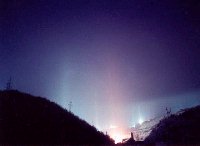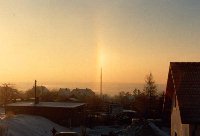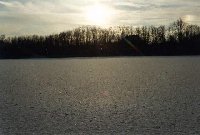by Claudia Hinz






In winter you can often see halos that do not form in the ice of cirrus clouds. The most beautiful, brightest and most colourful halos for example, form in freezing fog. In high pressure areas, in winter the dense cold air often sinks to the ground forming a cover of fog or low stratus clouds. The tops of the mountains, however, often stand out from that fog. When the temperatures in the fog are below freezing and the air, oversaturated with moisture can crystalize, an observer above the fog has the best preconditions to see a fantastic halo.
In the lowlands it is more difficult to observe halos in freezing fog because in fog there usually is no sunshine to illuminate the crystals. But there are pillars possible over artificial sources of light, for example street lamps. Other halos have not been observed around artificial sources of light up to now.
In plains halos can form in polar snow (also called ice needles or diamond dust) under certain circumsztances. These are very small ice crystals which frequently form under a cloudless sky when the moisture in the air crystalizes. Due to their low weight, these ice crystals often float in the air or fall to the ground very slowly. Even in this case the preconditions for their formation are a very high air humidity and temperatures below freezing. The lower the temperature is, the lower the relative humidity of the air has to be to saturate it and to form ice crystals.
| Air temperature in °C | 0 | -5 | -10 | -15 | -20 | -25 | -30 |
| Relative humidity in % necessary for saturation | 100 | 95 | 91 | 86 | 82 | 78 | 74 |
Valleys formed by a river or places near a river or a lake
are favoured to see these halos, but they can also be observed near factories
or power plants which eject vapour through chimneys. Otherwise, observations
are possible in the morning hours short after sunrise, when temperatures
reach their lowest level and the relative humidity of the air is highest.
Sundogs are the most frequent halos to be observed here. The reason is because
the sundogs are at the same level as are the eyes of the observer, where
the density of the diamond dust is highest.
Halos can not only appear
in diamond dust, but also